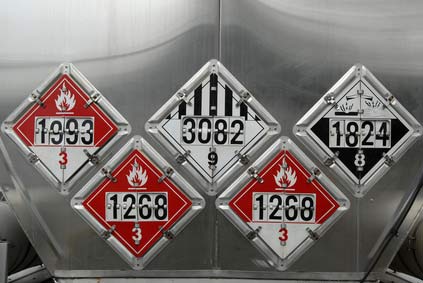The International Trade Blog Export Forms
How to Complete a Dangerous Goods Declaration without Blowing Up
On: September 17, 2014 | By:  David Noah |
4 min. read
David Noah |
4 min. read

Dangerous goods declarations are important when you’re shipping dangerous goods, but they’re also tedious and complex.
When you’re faced with exporting different types of dangerous goods, it’s up to you to responsibly and safely ship your products. Here are a few questions you must consider to help you complete a dangerous goods declaration without blowing up.
1. Do you know the requirements?
Don’t venture into exporting dangerous goods or hazardous materials without knowing what’s required by law. We recommend not only research, but a thorough hazardous materials training program for all employees who will be involved in packing and shipping these goods. We can’t stress this enough—you have to know what you’re doing if you plan on exporting hazardous materials and dangerous goods.
If you take this responsibility lightly and do not correctly classify your dangerous goods, you could be putting lives at stake, as well as risking fines and civil and criminal penalties.
Here is what constitutes dangerous goods:
- For international transportation by air, we have the definition provided by the International Civil Aviation Organization's (ICAO) Technical Instructions for the Safe Transportation of Dangerous Goods by Air and the UN model regulations: "Dangerous goods are articles or substances which are capable of posing a risk to health, safety, property or the environment."
- For the international transportation by vessel, the International Maritime Organization's (IMO) regulatory definition found in the IMDG Code (International Maritime Dangerous Goods Code) is: "Dangerous goods mean the substances, materials and articles covered by the IMDG Code."
2. Do you know which forms to use?
You will complete different documents depending on how you’re planning on transporting your goods.
- Use the Dangerous Goods IATA if you’re shipping by air.
The International Air Transport Association (IATA), which makes up the majority of the world`s airlines, uses the ICAO Technical Instructions for the Safe Transport of Dangerous Goods by Air as the basis for their dangerous goods regulations (IATA-DGR). - Use the Dangerous Goods IMO if you’re shipping by vessel.
Shipping dangerous goods internationally by vessel is regulated through the International Maritime Organization (IMO). The IMO is a specialized agency of the United Nations. The IMO uses the International Maritime Dangerous Goods Regulations Code (IMDG Code) as the basis for international enforcement of dangerous goods transportation by vessel.
3. Did you read all documents thoroughly?
Before you begin to fill out any form, you must know precise details about your goods: where they’re headed, quantity, their purpose, and what classifies the shipment as hazardous, to name only a few. By taking a thorough inventory of everything you must answer before you complete the dangerous goods form, you’ll save yourself a headache and potentially a lot of money in fines or delayed shipments.
Depending on the specific requirements of your hazardous materials shipment, Shipping Solutions Professional export documentation and compliance software may be an easy and seamless way to automatically integrate information you’ve already entered into your Dangerous Goods IATA and Dangerous Goods IMO forms. Watch the 12-minute Creating Dangerous Good Documents video for an overview of how the software works and then register for a free online demo of the software to see how it will help your company more quickly create the dangerous goods forms.
4. Did you pay special attention to these areas?
As you pack your goods and complete the required dangerous goods form, pay attention to these specific error-prone areas:
In packing your shipment:
- Before you complete any paperwork, follow guidelines for the nature and quantity of packaging. You can learn more about how to correctly and legal pack your shipments at the CARGOpak website.
- Make sure your carrier will accept your shipment. It seems obvious, but before you package and send your goods, you must know if your carrier works with dangerous goods or hazardous materials.
In your paperwork:
- Do not forget to mark whether your shipment is radioactive or not.
- For air shipments, under transport details, leave the airport boxes blank. Never use three-letter codes (i.e., DFW, DEN) for airports.
- Make sure you’re entering the correct descriptions of quantity and nature of your shipment as required by your product. It’s your responsibility to find out what information is required and report it accurately in the dangerous goods declaration.
- In the “place” cell, enter the physical address of the location where you completed the form. Keep in mind, this is not necessarily the shipper’s address.
- Do not neglect to enter any special provisions if your goods qualify. You are responsible for looking this information up, too!
5. Do you have any unanswered questions?
If you have any doubts about your dangerous goods or hazardous materials, do not pass go! Get your questions answered by an expert so you don’t put your business—and other’s livelihoods—at risk. To learn more about dangerous goods shipping requirements and training, including more details on the correct way to complete the dangerous goods forms, visit CARGOpak online.
Like what you read? Join thousands of exporters and importers who subscribe to Passages: The International Trade Blog. You'll get the latest news and tips for exporters and importers delivered right to your inbox.

About the Author: David Noah
As president of Shipping Solutions, I've helped thousands of exporters more efficiently create accurate export documents and stay compliant with import-export regulations. Our Shipping Solutions software eliminates redundant data entry, which allows you to create your export paperwork up to five-times faster than using templates and reduces the chances of making the types of errors that could slow down your shipments and make it more difficult to get paid. I frequently write and speak on export documentation, regulations and compliance issues.

